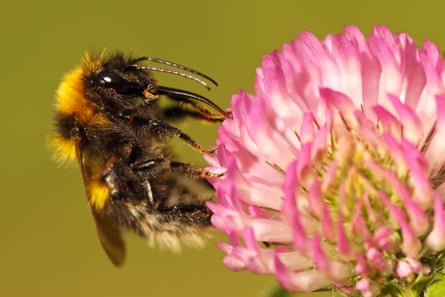Gardeners hoping to establish a wildflower patch in their gardens should be wary of generic seed mixes and stick to local blooms to best serve wild pollinators, experts have said.
Conservationists are urging people to source not just native wildflowers but to find out what grows naturally in their neighbourhood by getting out in their area and looking for inspiration in existing meadows, verges and nature reserves. They should then use this as a guide to ensure they are collecting or buying the most suitable wildflowers for their gardens.
Swedish researchers who study pollination and biodiversity at Lund University reiterated the importance of going local as the wildflower season blooms across Europe. “Don’t collect seeds further away than you can cycle is usually a good rule of thumb,” said ecologist Maj Rundlöf. Nearly one in 10 wild bee species faces extinction in Europe, data suggests, and the public is increasingly keen to help them. She believes there should be more information available about what to put where.
Rundlöf said: “It’s like our food, without knowing where something comes from, we wouldn’t know how to make the right choice. It’s the same with these seeds – labelling is important because it provides people with the information that enables them to choose.”
Seed suppliers in Sweden are wrongly marketing their ready-mixed seeds as meadow flowers when the packets contain ornamental plants and grassy weeds from abroad that should not be in a traditional meadow, said Rundlöf and her colleague, Lina Herbertsson. The Swedish Botanical Society is calling for packets of wildflower seeds to carry labels showing their origin to prevent people accidentally spreading non-native species in the wild.
In the UK, sourcing seeds from local donor sites – provided it is in line with official guidance – will help rejuvenate the country’s regional wildflower meadows, which are all different and have adapted to local soils and pollinator populations. Local nature reserves or nature-friendly farmers may be able to share their seeds at the end of the summer.

Matt Pitts, a meadows adviser at Plantlife, in the UK, said: “Our old meadows have subtle differences – there might be species that only grow well in Devon and Cornwall, for example.”
The problem with wildflower seed mixes – even if they are native – is that they are often one-size fits all. “You’re getting generic wildflower mixes and starting to lose regional diversity,” Pitts said. Some packets of seeds incorrectly labelled as “wildflower meadow mixtures” often contain common poppies, corn marigolds and cornflowers, which don’t occur naturally in that combination in any habitat in Britain, according to Plantlife.
Many insects only like visiting specific plants. For example, long-tongued bumblebees are well suited to pollinating red clover, and orange-tip butterflies lay their eggs on lady’s smock. Typical insect-friendly meadow flowers in the UK are oxeye daisy, common knapweed, bird’s-foot trefoil and field scabious.
A good meadow should not just be a food source for pollinators, but should provide winter forage and a mix of grasses all year round, said Pitts.
Another solution is to just wait and see what comes up, using a natural regeneration method that is also recommended for woodland restoration. Leaving grass to grow long as part of “no mow May” is an opportunity to see what wildflowers naturally emerge in your garden, and you may be surprised at what pops up if you leave the mower in the shed.

More than 250 wild plant species were recorded by gardeners in the UK last year, including wild garlic, snake’s head fritillary and meadow saxifrage. “Some seeds will lie dormant for tens of years,” said Pitts. “To me, that’s a nice thing, and it’s interesting, you never know what is going to come up … We’re so used to wanting instant success but you’ve got to wait and be a bit patient.”
Five native flowers to seek out in the UK
Yellow rattle: often recommended as a wildflower to spread on to grass, as it is a parasitic plant that acts as “nature’s lawnmower”, stunting the growth of dominant grasses and giving more delicate wildflowers space to come through
Oxeye daisy: a UK favourite, loved by gardeners, bees and butterflies
Common knapweed: its purple thistle-like flowers are guaranteed to attract a kaleidoscope of butterflies
Common bird’s-foot trefoil: loved by pollinating insects for its nectar, the yellow flowers will brighten up any wild patch
Field scabious: an attractive, delicate flower much loved by bees and birds
Find more age of extinction coverage here, and follow biodiversity reporters Phoebe Weston and Patrick Greenfield on Twitter for all the latest news and features

